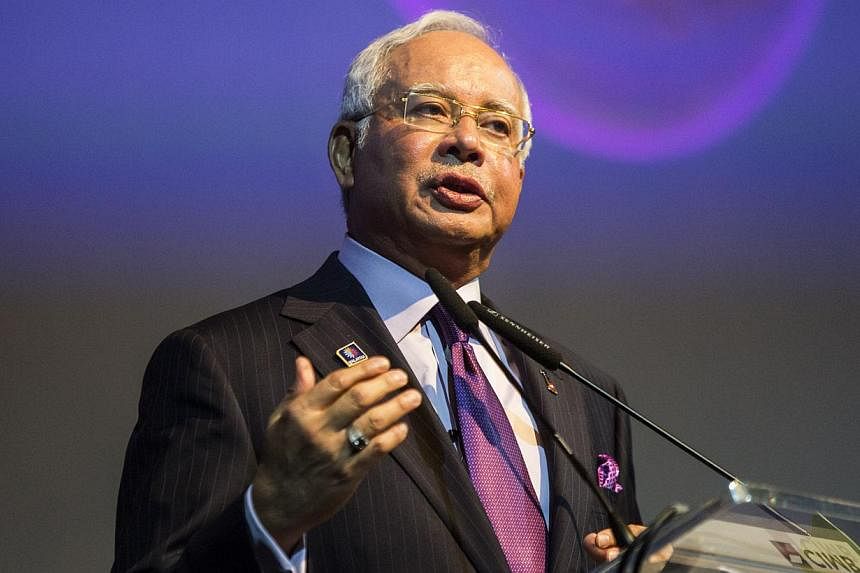Malaysian Prime Minister Najib Razak, who unveiled an ambitious five-year economic development plan on Thursday (May 21), is confident that his country can achieve developed economy status by 2020.
The 11th Malaysia Plan (11MP), which is the final one in the lead-up to the 2020 goal, includes updated forecasts for the country's economy and its finances, as well as new infrastructure projects. Here are some highlights of the plan:
Economic outlook
- Real gross domestic product (GDP) is expected to expand between 5 and 6 per cent per annum from 2016-2020, resulting in a 7.9 per cent per annum rise in gross national income (GNI) per capita;
- Malaysian economy to benefit from more robust global economic prospects, recovery of commodity prices and benign global inflation;
- Malaysia's GDP to hit RM2.6 trillion (S$970 billion) in 2030
Inflation
Inflation to remain below 3 per cent from 2016-2020
Investment
- Private investment expected to grow at an annual 9.4 per cent between 2016 and 2020, estimated annual investment at RM291 billion
- Public investment to grow at 2.7 per cent per annum at an annual average of RM131 billion
Exports
- Gross exports projected to see stronger growth at 4.6 per cent per annum between 2016 and 2020
- Trade balance projected to remain positive with surplus of RM57.3 billion by 2020
Gross National Product
- Gross national income per capita expected to reach US$15,690 (S$20,982) by 2020
Tax
- Goods and services tax expected to bring in RM31.4 billion revenue a year over next five years
Debt
Federal government total debt projected to drop below 45 per cent by 2020
Oil
- Dependence on oil-related revenue to decline to 15.5 per cent by 2020
Workforce
More than 40 per cent of total employment will comprise skilled workers
Major projects
- Kuala Lumpur-Singapore High Speed Rail
- Klang Valley Mass Rapid Transit 2 and 3
- Klang Valley Light Rapit Transit 3
- 3,000km of new paved roads
Moving low-income households to middle-class society
Malaysia has 2.7 million households in the bottom 40 per cent (B40) of society. B40 households have a mean monthly income of RM2, 537. The government aims to double this amount to RM5, 270 in 2020. The income share of the B40 to national household income will also increase from 16.5 per cent in 2014 to 20 per cent in 2020.
Broadband coverage
High-Speed Broadband 2 (HSBB 2) and Suburban Broadband (SUBB) will be rolled out to ensure that 95 per cent of the country will have broadband coverage. The HSBB 2 proposes to cover all state capitals and selected high-impact growth areas that will see 250,000 ports encompassing 410,000 premises by end-2016. It also eyes 100 Mbps broadband being made available to all households in the areas involved by 2020. While the Suburban Broadband initiative will cover suburban and rural areas, it is targeted that an additional 420,000 ports encompassing 750,000 premises will be installed within five years of the start of the project with 20 Mbps broadband made available to 50 per cent of households by 2020.
Empowering the Bumiputera economic community
The government will empower Bumiputera human capital, high-skills training and certified professional programmes such as the Skills Steering Programme under the Bumiputera Education Steering Foundation. Bumiputera participation in high-skill jobs is expected to reach 60 per cent by 2020. The government has also set a goal of a minimum 90 per cent of Bumiputera households owning their own homes by 2020. Bumiputera Commercial Property Revolving Fund will be established to assist entrepreneurs to acquire commercial properties, and this initiative will enable Bumiputera entrepreneurs to shift from renting to owning properties.
Affordable housing
The government plans to develop 606,000 houses for low- and middle-income households. An additional 47,000 houses will be built or repaired for the poor, which will be carried out between 2016 and 2020. Financing schemes will also be enhanced to improve access and affordability for low- and middle-income households.
Human Capital Development
The government will focus on four key areas to accelerate human capital development: Improving the labour market efficiency to accelerate economic growth; transforming the technical vocational education and training (TVET) to meet industry demand; improving the quality of education for better student outcomes and institutional excellence, and strengthening life-long learning for skills enhancement. It is projected that 1.5million jobs will be created of which 60 per cent will involveTVET-related skills.
SOURCE: Reuter, Bernama, The Star/Asia News Network

